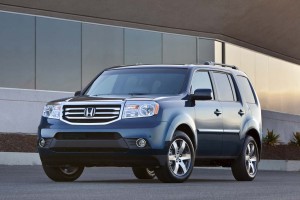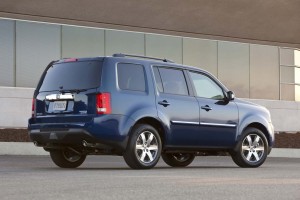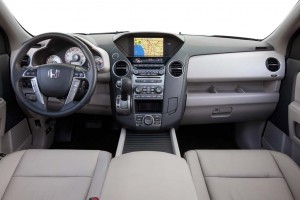Honda has finally pulled the covers off the new 2012 Pilot, one of the market’s most popular 3-row crossover vehicles.
Somewhat surprisingly, the changes to the 2012 Honda Pilot appear to emphasize a more traditionally boxy SUV-style shape for its makeover, even as other makers are adopting softer, more CUV designs.
The big news for the new model-year is that Pilot’s highway fuel efficiency jumps to 25 miles per gallon on front-wheel-drive models, an increase of 2 mpg. That would make the 2012 Honda Pilot the most fuel-efficient model in the 8-passenger crossover segment, the maker boasts.
There had been some concern about the roll-out of Honda’s upcoming products — the CR-V being delayed by several months due to the March 11 Japanese earthquake and tsunami. Resultant parts shortages slammed the maker just after it launched the new 2012 Honda Civic, for example, which will effectively be re-launched for the new model-year. The good news for Pilot fans is that it’s hitting market on time, despite Honda’s challenges.
The debut of the updated Pilot will be particularly critical because it is not only one of the maker’s top sellers but it also has to reverse recent, often-sharp criticism of the Honda brand. Notably, the influential Consumer Reports magazine not only criticized the new Civic but took aim at Honda itself.
(Honda’s new marketing chief Mike Accavitti looks at the impact of the CR reviews. Click Here for more.)
The most notable difference with the 2012 Pilot is the switch to a 3-bar “chrome-style” grille, which Honda suggests “conveys a more sophisticated crossover SUV appearance.” Inside, the updated ute gets a revised instrument panel with its controls organized in a more “intuitive button layout.” There are a number of new technical features, including the 8-inch intelligent display on the Pilot EX-L, and updated Bluetooth and audio systems.
But the emphasis is on mileage, which reflects changes made not only to the Pilot powertrain but also to the CUV’s chassis and aerodynamics. All models feature a 3.5-liter SOHC V-6 making 250 horsepower and 253 lb-ft of torque.
In 2WD trim the 2012 Honda Pilot will get 18 mpg City, 25 Highway and 21 Combined. In all-wheel-drive configuration that dips slightly to 17/24/20.
Honda has traditionally positioned the 8-seat Pilot as a sort of minivan among utility vehicles.




From the photos, it looks like the cargo area may be flat in the 2012. The 2011 has a sloped cargo area that makes soccer balls roll into the street. Do you know if that was changed?
Apparently not. Here are some relevant notes from the maker’s press release:
The tailgate features a lift-up glass hatch for convenient access to the rearmost cargo area. The model’s 18.0 cubic-feet of cargo space behind the third row matches or exceeds the trunk space of a typical large sedan and can accommodate items as large as a mid-size cooler or a folded stroller. For maximum cargo space, the second and third rows fold flat into the floor to create 87.0 cubic feet of storage capacity, while also providing sufficient width for 4-foot-wide items.
The cargo area has a hidden storage well that provides 2.8 cu-ft. of additional space and can combine with the above floor storage area by securing the hinged cover against the seatback. The Pilot Touring also provides a load-supporting cargo net (20 lbs. maximum weight) to further subdivide the rear cargo area.
Key interior dimensions are identical to the previous Pilot model, including front headroom (40.0 in. for Pilot LX and EX, 39.3 in. for moonroof-equipped Pilot EX-L and Touring), second-row headroom (39.8 in.) and rear headroom (38.2 in.), legroom (front 41.4 in., second-row 38.5 in., and third-row 32.1 in.). Passenger volumes are likewise identical (153.7 cu-ft. for Pilot LX and EX, 152.7 cu-ft. for Pilot EX-L and Touring), as are cargo volumes (87.0 cu-ft. total, 47.7 cu-ft. behind second-row seats, and 18.0 cu-ft. behind third-row seats).